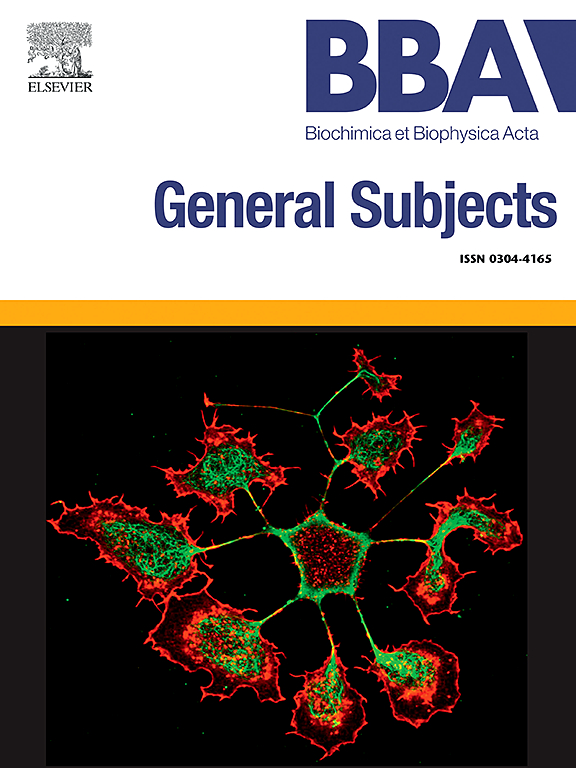Unlocking the influence of PNPLA3 mutations on lipolysis: Insights into lipid droplet formation and metabolic dynamics in metabolic dysfunction-associated steatotic liver disease
IF 2.2
3区 生物学
Q3 BIOCHEMISTRY & MOLECULAR BIOLOGY
Biochimica et biophysica acta. General subjects
Pub Date : 2025-01-19
DOI:10.1016/j.bbagen.2025.130766
引用次数: 0
Abstract
Background
Metabolic dysfunction-associated steatotic liver disease (MASLD) covers a range of liver conditions marked by the buildup of fat, spanning from simple fatty liver to more advanced stages like metabolic dysfunction-associated steatohepatitis and cirrhosis.
Methods
Our in-depth analysis of PNPLA3_WT and mutants (I148M (MT1) and C15S (MT2)) provides insights into their structure-function dynamics in lipid metabolism, especially lipid droplet hydrolysis and ABHD5 binding. Employing molecular docking, binding affinity, MD analysis, dissociation constant, and MM/GBSA analysis, we delineated distinct binding characteristics between wild-type and mutants.
Results
Structural dynamics analysis revealed that unbound mutants exhibited higher flexibility, increased Rg and SASA values, and broader energy landscapes, indicating multiple inactive states. Mutations, especially in PNPLA3_MT1, reduced the exposure of the catalytic serine, potentially impairing enzymatic activity and LD hydrolysis efficiency. Altered interaction patterns and dynamics, particularly a shift in ABHD5 binding regions towards the C-terminal domain, underscore its role in LD metabolism. Energy dynamics analysis of the protein complexes revealed PNPLA3_WT exhibited multiple low-energy macrostates, whereas the mutants displayed narrower energy landscapes, suggesting a more stable functional state. PNPLA3_MT1 demonstrated the highest affinity towards ABHD5, highlighting the complex interplay between protein structure, dynamics, and lipid metabolism regulation.
Conclusion
PNPLA3_MT1 mutant exhibits the highest flexibility and significantly reduced catalytic serine accessibility, leading to impaired lipolysis. Contrarily, PNPLA3_WT maintains stable catalytic efficiency and effective LD hydrolysis, with PNPLA3_MT2 displaying intermediate behavior.
General significance
Our research provides valuable insights into the metabolic implications of PNPLA3 mutations, offering a path for potential therapeutic interventions in MASLD.
解锁PNPLA3突变对脂肪分解的影响:代谢功能障碍相关脂肪变性肝病中脂滴形成和代谢动力学的见解
背景:代谢功能障碍相关的脂肪性肝病(MASLD)涵盖了一系列以脂肪堆积为特征的肝脏疾病,从简单的脂肪肝到代谢功能障碍相关的脂肪性肝炎和肝硬化等更高级的阶段。方法:通过对PNPLA3_WT及其突变体(I148M (MT1)和C15S (MT2))的深入分析,深入了解其在脂质代谢中的结构-功能动力学,特别是脂滴水解和ABHD5结合。通过分子对接、结合亲和力、MD分析、解离常数和MM/GBSA分析,我们描绘了野生型和突变体之间不同的结合特征。结果:结构动力学分析显示,未结合突变体具有更高的灵活性,Rg和SASA值增加,能量景观更宽,表明存在多种失活状态。突变,特别是在PNPLA3_MT1中,减少了催化丝氨酸的暴露,潜在地损害了酶活性和LD水解效率。相互作用模式和动力学的改变,特别是ABHD5结合区域向c端结构域的转移,强调了它在LD代谢中的作用。蛋白质复合物的能量动力学分析显示,PNPLA3_WT具有多个低能宏观状态,而突变体具有更窄的能量景观,表明其功能状态更稳定。PNPLA3_MT1对ABHD5的亲和性最高,这表明了蛋白质结构、动力学和脂质代谢调节之间的复杂相互作用。结论:PNPLA3_MT1突变体表现出最高的柔韧性,并显著降低了催化丝氨酸的可及性,导致脂肪分解受损。相反,PNPLA3_WT保持稳定的催化效率和有效的LD水解,而PNPLA3_MT2表现出中间行为。总体意义:我们的研究为PNPLA3突变的代谢意义提供了有价值的见解,为MASLD的潜在治疗干预提供了一条途径。
本文章由计算机程序翻译,如有差异,请以英文原文为准。
求助全文
约1分钟内获得全文
求助全文
来源期刊

Biochimica et biophysica acta. General subjects
生物-生化与分子生物学
CiteScore
6.40
自引率
0.00%
发文量
139
审稿时长
30 days
期刊介绍:
BBA General Subjects accepts for submission either original, hypothesis-driven studies or reviews covering subjects in biochemistry and biophysics that are considered to have general interest for a wide audience. Manuscripts with interdisciplinary approaches are especially encouraged.
 求助内容:
求助内容: 应助结果提醒方式:
应助结果提醒方式:


